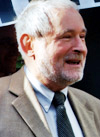EGU Milutin Milankovic Medallist 2006
|
Michael Sarnthein for his valuable work on Quaternary climate changes, and for his leadership role in the palaeoceanographic investigations of deep-sea sediments from the Atlantic, Pacific and Indian oceans. |
Michael Sarnthein is one of the leading paleoclimatologists and marine geologists in the world. He played a central role in the development of paleoceanography in Germany, and became a major player in the international community. He has published extensively and has contributed significantly to better understanding of Quaternary Ocean and climate history. The standard of excellence of his contributions his insistence on detail and high chronological resolution have provided crucial insight into oceanic processes involved in abrupt and orbital-scale climate change. He has been a leader in setting high standards of investigation that have generally improved the quality and rigour of investigations utilizing deep-sea sediments. He has also pioneered the multi-proxy approach that has proven invaluable for the interpretations of past environmental change.
Michael Sarnthein is one of the world's foremost authorities on the paleoceanographic history of the high-latitude North Atlantic Ocean. He was an important contributor to the discovery that a sequence of abrupt ocean circulation changes was associated with deglacial events involving different ocean states in the north Atlantic. He has been able to relate these changes in state to meltwater events, ice sheet instability and surface water salinity and temperature changes and to place them within the most solid of radiocarbon chronologies of any studies in the world. In doing so he has been able to help demonstrate the strong linkage between deep-water circulation and climate change at high latitudes.
Throughout the last several decades, Michael Sarnthein has always been at the forefront. His extensive work on the Quaternary history of West African margin upwelling was an early demonstration of connections between climate change and surface ocean productivity, organic carbon deposition and the carbon isotopic record. These studies had important implications for explaining variations in atmospheric carbon-dioxide concentrations. He also made early and important advances in understanding of the sedimentary environment of the monsoon history in the Arabian and China Seas. His work also includes one of the earliest demonstrations of the remarkable extent of aridity of the earth during the last glacial episode.
Michael Sarnthein's impact on the advancement of science also involved many technical and organizational activities. He was the primary force behind the development of the "Kiel Device" for automated analysis of the stable isotopic composition of carbonates, now widely employed in laboratories; he led the development of an important AMS radiocarbon laboratory in Germany; he effectively served in numerous leadership roles in international committees on climate change, and directed, for some time, the important IMAGES coring program which led to major advances in understanding abrupt climate change and ocean margin paleoceanography. Furthermore, he has produced many graduate students of the highest quality who, in turn, have contributed significantly to scientific advances. These former students now take their places as valued members of the international paleoclimate community where, combined with their mentor's technical and scientific contributions, they serve as the continuing legacy of Michael Sarnthein.

